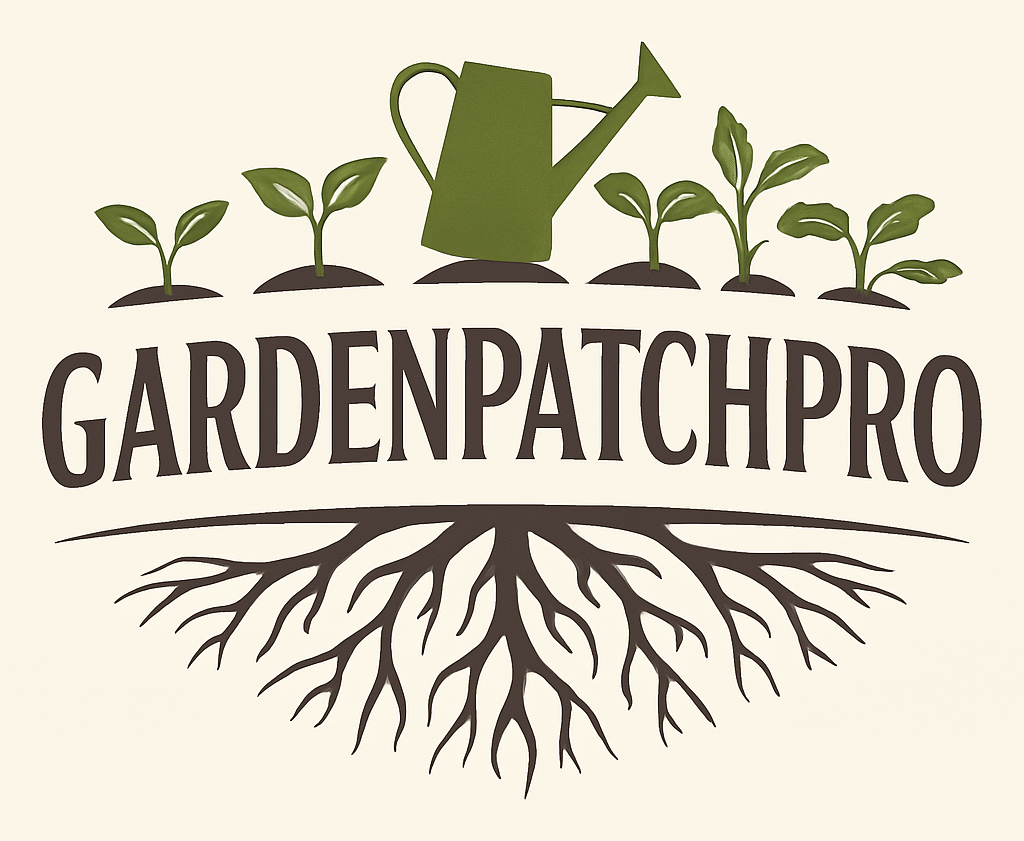12 Lawn Alternatives for Sustainable and Easy Yard Solutions
Many people are rethinking traditional grass lawns because they can be hard to maintain and use a lot of water. Alternatives to grass offer different options that can suit various needs and climates. These choices can help reduce yard work and environmental impact without sacrificing outdoor space.
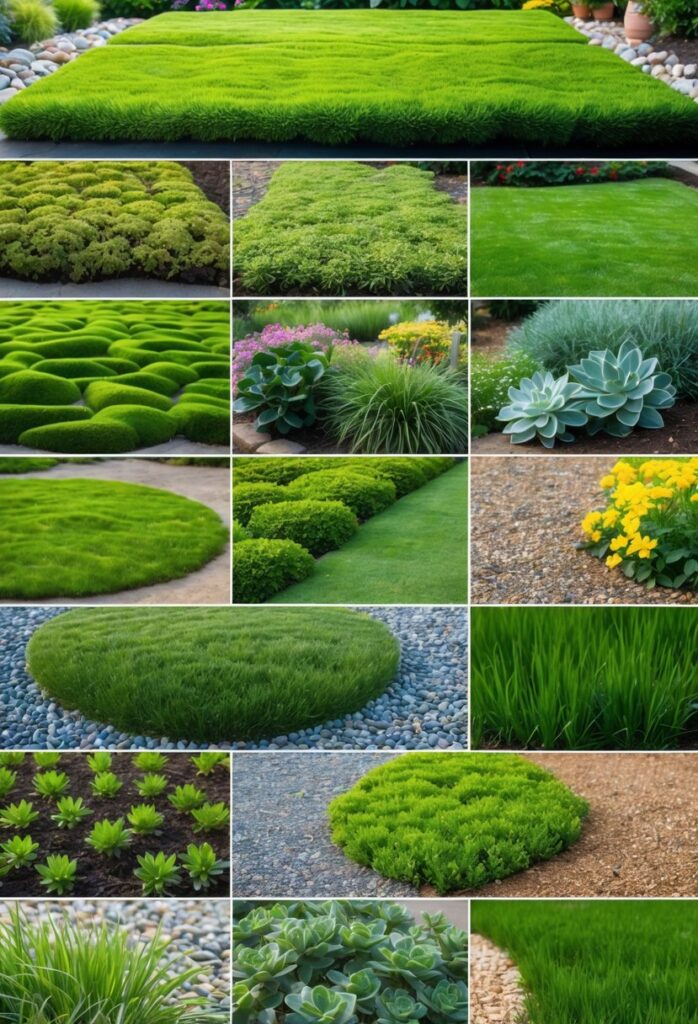
The main benefit of exploring lawn alternatives is finding low-maintenance, eco-friendly options that save time and resources. These options can create attractive, functional outdoor areas that support local ecosystems and require less water and care.
1) White Clover
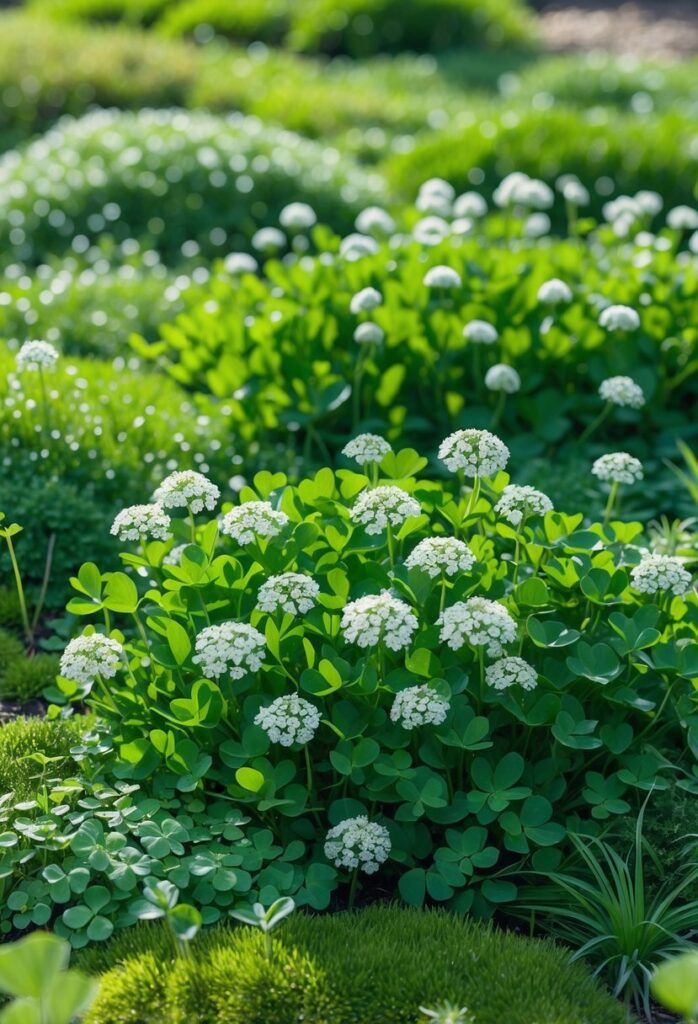
White clover is a popular alternative to traditional grass lawns. It grows low to the ground and stays green for most of the year. It requires less mowing than grass, which saves time and effort.
This plant is drought-tolerant and can thrive in soils with low fertility. It also adds nitrogen to the soil, improving its quality naturally. White clover attracts pollinators such as bees, which helps local wildlife.
Unlike grass, white clover needs little fertilizer and fewer pesticides. It is often used as a cover crop or mixed with other plants for a fuller lawn. There are different types, including Dutch clover, which is commonly used for lawns.
White clover can handle some foot traffic but may not be as durable as grass under heavy use. It grows well in sun and partial shade, making it versatile for many areas. White clover is an eco-friendly choice for those wanting a low-maintenance lawn alternative. More details on its benefits and uses are available from White Dutch Clover Alternative Lawn Seed.
2) Buffalo Grass (UC Verde)
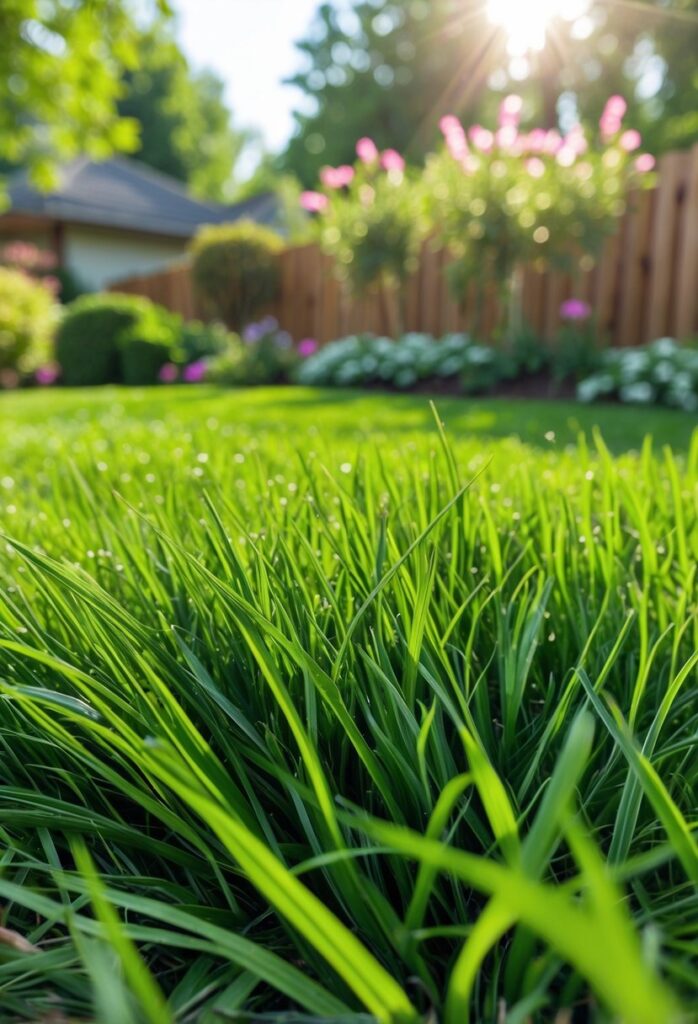
Buffalo grass, especially the UC Verde variety, is a drought-tolerant lawn alternative. It needs very little water, making it a good choice for dry climates. UC Verde grows between 4 to 8 inches tall and does not require frequent mowing.
This grass has a low pollen count compared to traditional lawn grasses. That can help reduce allergies in people sensitive to pollen. It also has a natural look, suited for those wanting a green lawn without much upkeep.
UC Verde can handle heat well and survives Phoenix summers. It is native to the prairies of the Midwest, so it is adapted to harsh conditions. While it has lower traffic tolerance than some grasses, it works well in many residential settings.
It requires low maintenance and fewer resources overall. This makes UC Verde a sustainable lawn option. More details about its care and benefits are available on sites like California Lawn Alternatives.
3) Catlin Sedge
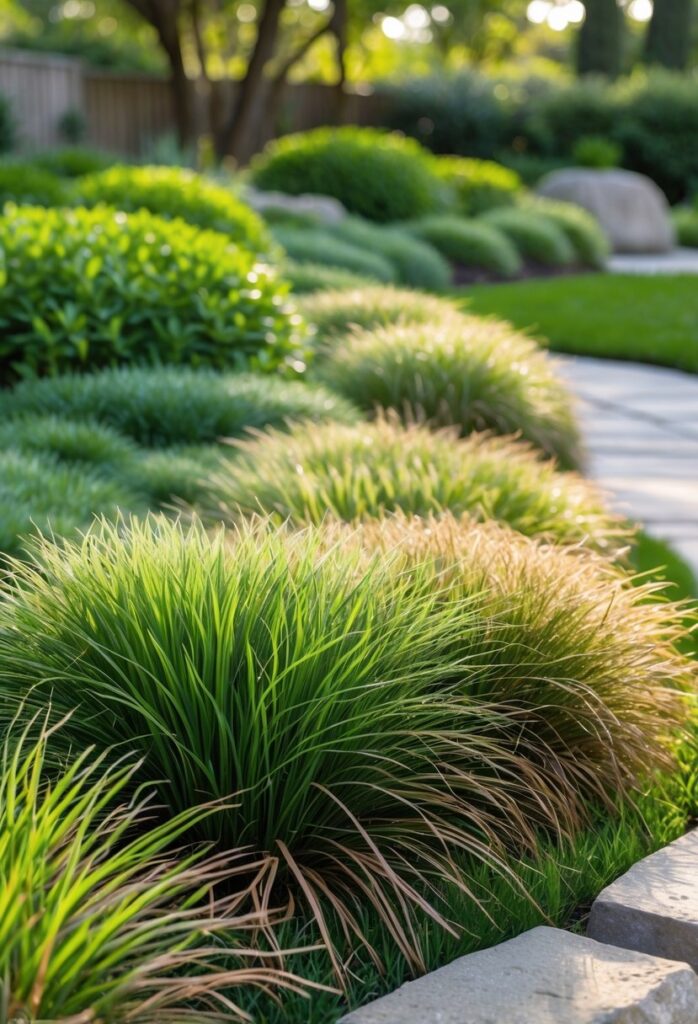
Catlin sedge (Carex texensis) is a popular lawn alternative native to Texas and nearby areas. It grows low, about 6 to 12 inches tall, making it suitable for a natural, no-mow lawn.
It thrives in well-drained soil and can tolerate heat and drought better than many traditional grasses. This makes it a good choice for dry or sunny areas.
Catlin sedge spreads to form a dense groundcover that is soft underfoot. It does well in zones 5 to 9 and can handle some foot traffic.
It is often used where low maintenance and sustainability are priorities. It requires less water and care than typical turf grasses.
Because it is a sedge, it blends well with other native plants and can improve soil health. More information on Catlin sedge can be found at The Pollen Nation and Brooklyn Botanic Garden.
4) Dymondia
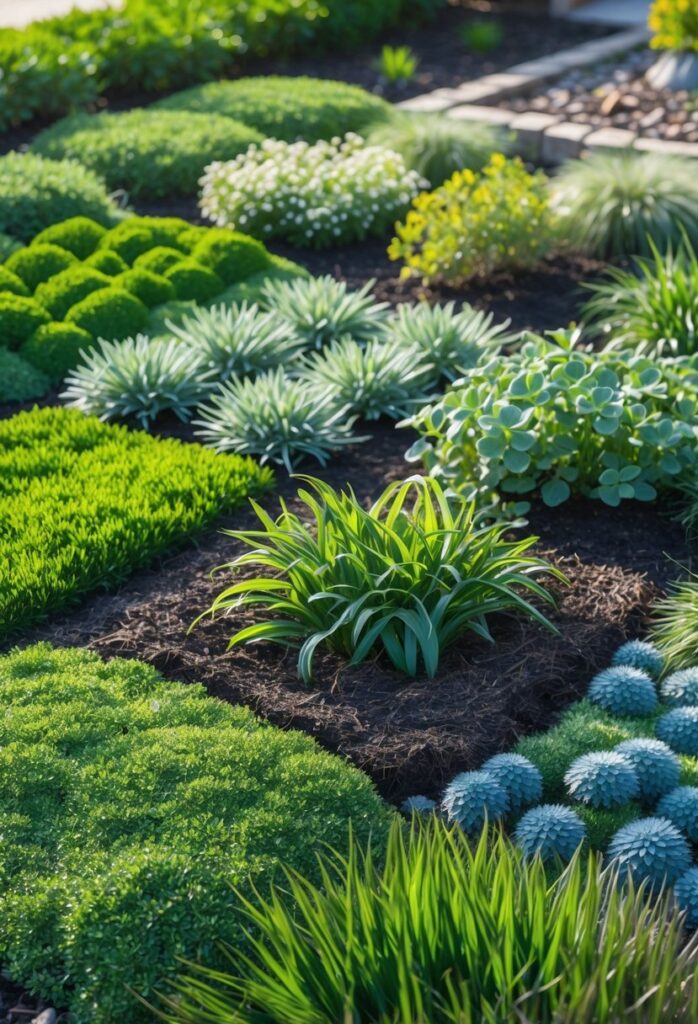
Dymondia is a low-growing ground cover that works well as a lawn alternative. It has a dense, silver-green carpet-like appearance. This plant is drought-tolerant and does well in sunny or lightly shaded areas.
It is slow to establish but becomes sturdy once grown. Dymondia can handle light foot traffic, but heavy play or running may damage it. Using flat paving stones can help protect it in busy areas.
Because it is deep-rooted, Dymondia can survive dry periods with less water than traditional grass. It also helps reduce lawn maintenance since it requires less mowing and fertilizing.
Its natural form fits well between patios or pathways and helps prevent weed growth. Dymondia is best suited for homeowners looking for a green, low-water lawn option with moderate durability.
For more details about growing and care tips, see the information on drought-tolerant lawn substitutes and advice on Dymondia lawns.
5) Kurapia
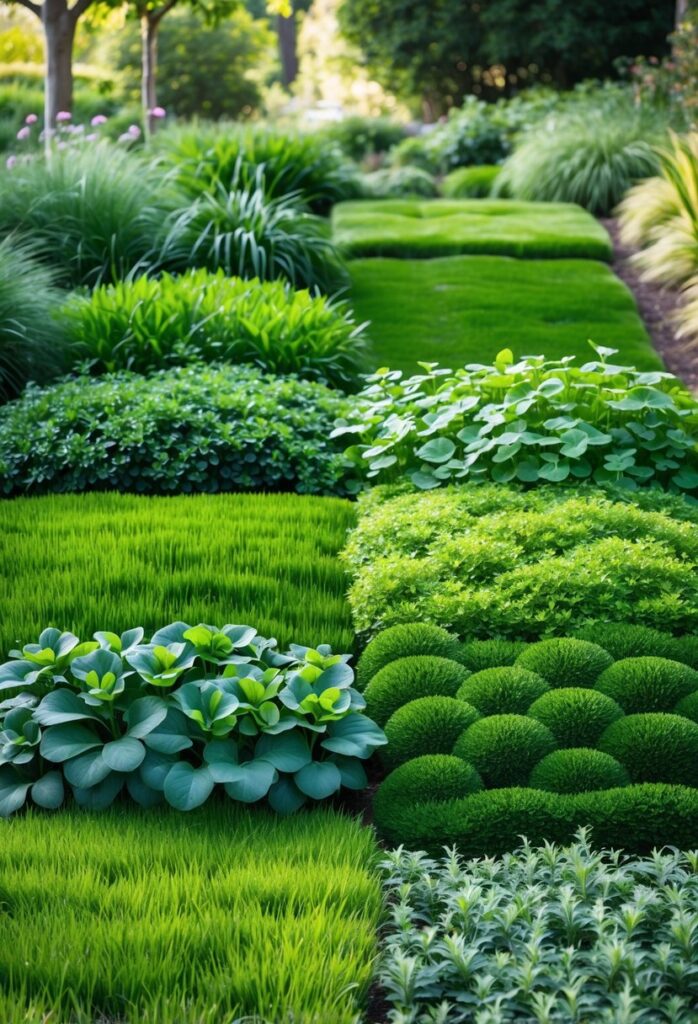
Kurapia is a drought-tolerant ground cover that works well as an alternative to traditional grass lawns. It stays green year-round and needs much less water than regular turf.
It requires little maintenance, so it saves time on mowing, watering, and fertilizing. Kurapia also helps control erosion and reduces weed growth naturally.
This plant thrives in hot, dry climates, making it a good choice in places like California and Arizona. It spreads quickly and forms a dense cover that looks similar to grass but is hardier.
Kurapia supports the environment by conserving water and providing habitat for pollinators. It is suitable for both residential yards and larger commercial or public spaces.
For more details, see the information on Kurapia as a low-water lawn alternative.
6) Thyme
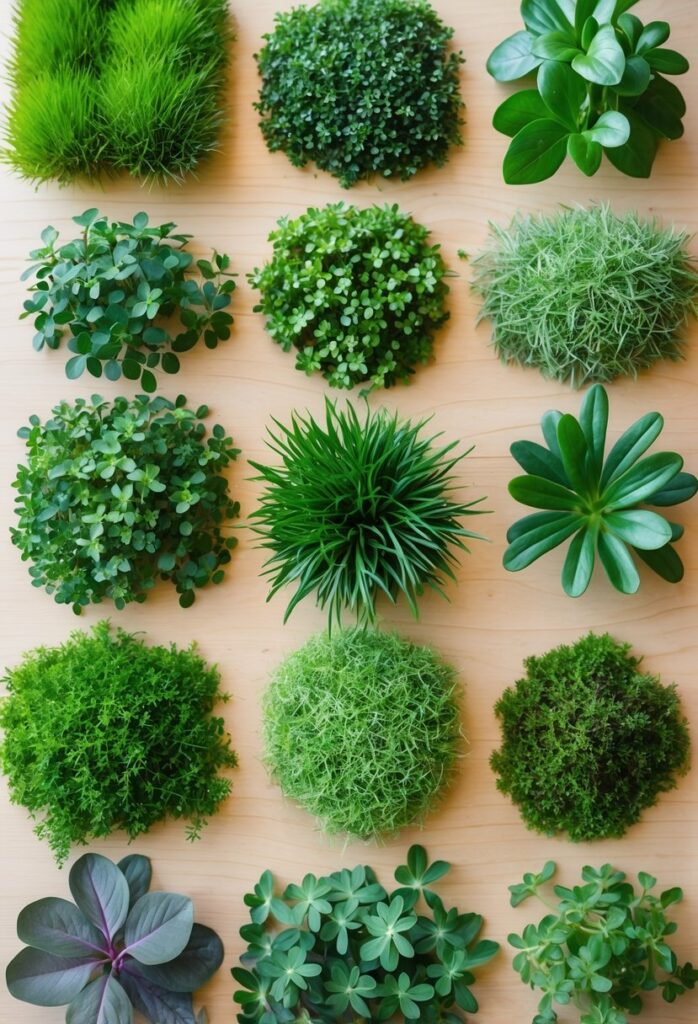
Thyme is a popular lawn alternative known for its drought tolerance. It grows well in well-draining soil and can survive in a wide range of climates, specifically Zones 4 to 9. It is a low-growing plant, making it suitable for small lawn areas.
This groundcover is easy to maintain and requires little water once established. Thyme can handle light foot traffic, though some varieties, like creeping thyme, are better for walking on than others.
Thyme also produces small flowers that attract pollinators. It has a pleasant fragrance that many people enjoy when walking barefoot.
However, thyme can be slower to spread compared to other lawn replacements such as clover or oregano. It may also need occasional weeding as some unwanted plants can grow alongside it.
For those looking for a water-saving and attractive lawn substitute, thyme is a solid choice. More details about thyme as a lawn alternative can be found in this article on grass lawn replacements.
7) Red Fescue

Red Fescue is a fine-textured grass that grows well in cooler climates. It forms a dense mat of leaves, which helps reduce weeds.
It is low-maintenance and needs less water compared to many other lawn grasses. This makes it a good choice for areas with moderate drought.
Red Fescue can handle some shade better than many turf grasses, but it also grows well in full sun. It stays green for most of the year.
Because it does not require many fertilizers or pesticides, Red Fescue is often favored for eco-friendly lawns. It offers a natural look without much effort.
This grass is a common option in lawn replacement lists and is praised for its ability to create a soft, durable surface. Learn more about Red Fescue as a lawn alternative at Grass Alternatives for Low-Maintenance Lawn Landscaping.
8) Moss
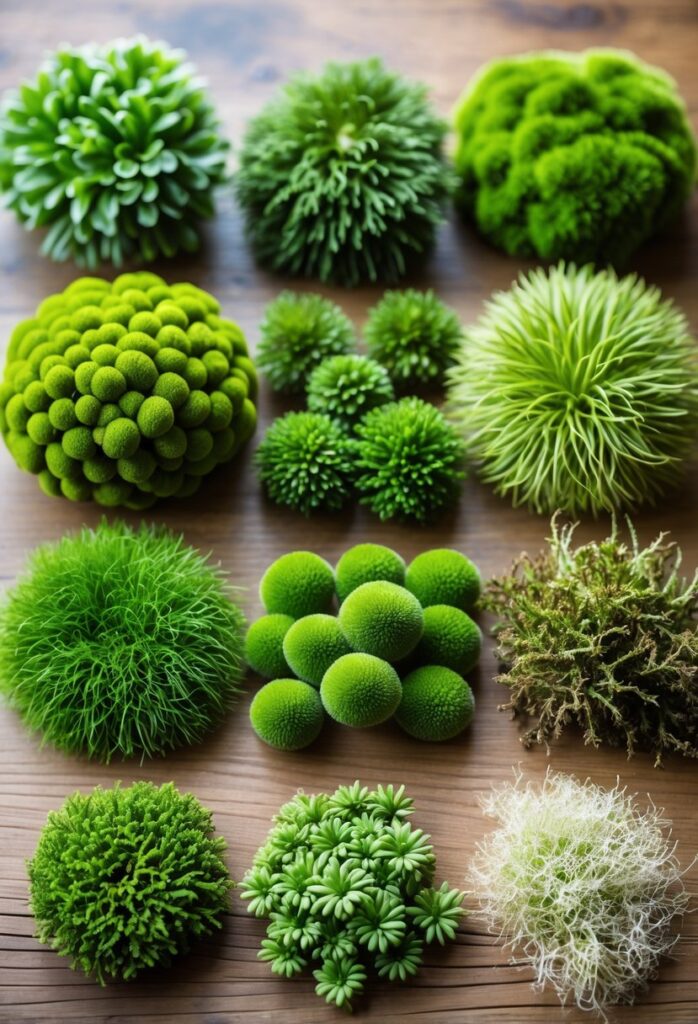
Moss is a low-growing plant that can serve as a lawn alternative in shady, damp areas. It requires little mowing or watering once established. This makes it a good option for people looking for a low-maintenance yard.
It grows best in acidic soils with good shade and moisture. However, if grown in dry or sunny spots, moss can become difficult to keep healthy.
Moss lawns provide a soft, green ground cover that can withstand light foot traffic. They also help reduce soil erosion and support local ecosystems by retaining moisture.
Once established, moss needs less fertilizer and no pesticides. It can be a sustainable choice for replacing traditional grass in certain environments. More details on moss as a lawn option are available at Can I Replace My Lawn with Moss? A Comprehensive Guide.
9) Blue Star Creeper
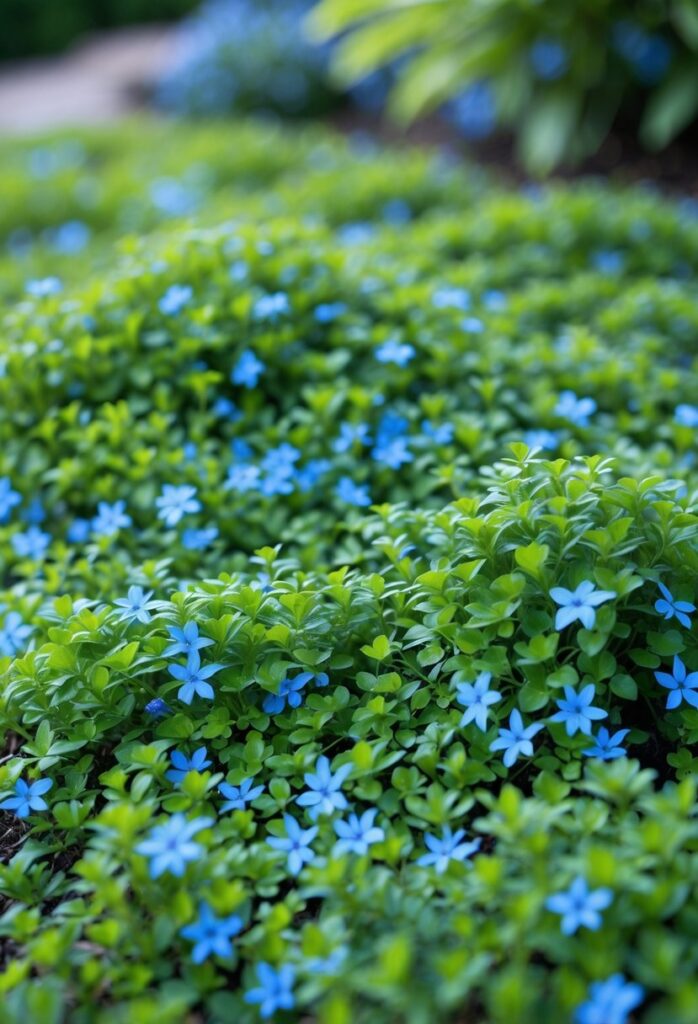
Blue Star Creeper is a low-growing ground cover that works well as a lawn alternative. It forms a dense, green mat with small blue flowers that add color to the yard. It can handle light foot traffic, making it suitable for pathways and no-mow lawns.
This plant tolerates both sun and shade but prefers moist soil, especially in full sun. It needs regular watering to stay healthy. Applying fertilizer before new growth helps maintain its vigor.
Blue Star Creeper does not need mowing and spreads quickly, which helps reduce weed growth. However, it can be aggressive, so some control may be necessary to keep it contained. Its low maintenance needs make it popular for those wanting a simple, attractive ground cover. More details about its care and use are available at Blue Star Creeper Plant Care.
10) Corsican Mint
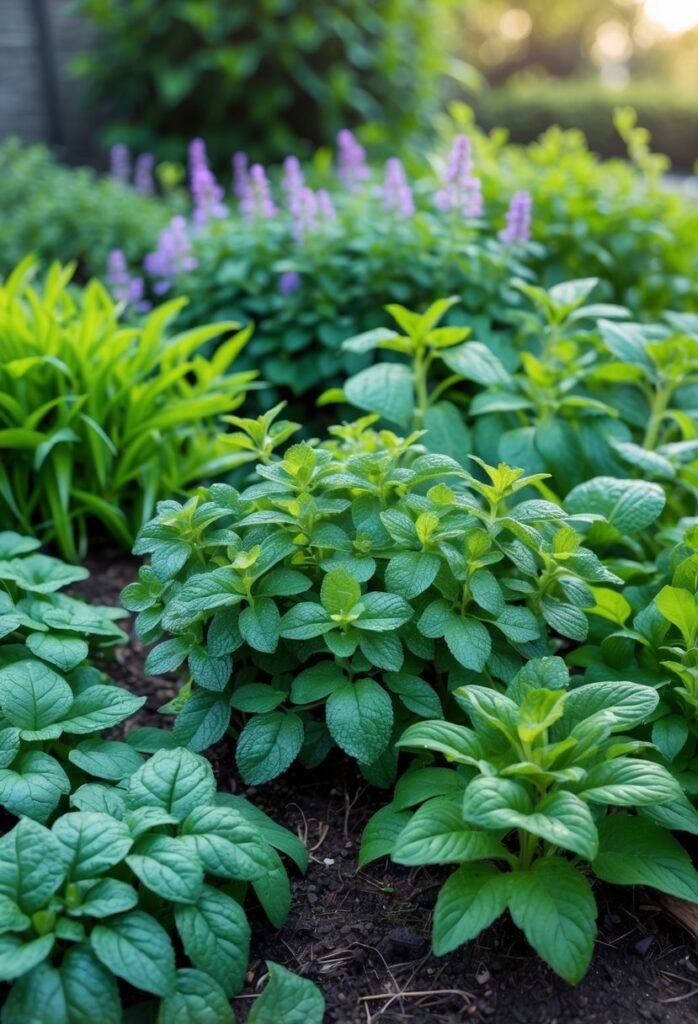
Corsican Mint is a low-growing ground cover that spreads quickly. It thrives in shady, moist areas, making it a good choice for lawns with less sunlight.
It releases a pleasant mint scent when walked on. This adds a sensory element to outdoor spaces without needing flowers or high maintenance.
The plant stays green most of the year but is best suited for mild climates. It does not tolerate heavy foot traffic like traditional grass.
Corsican Mint needs well-drained soil and regular watering during dry spells. It requires little mowing or trimming, which reduces lawn care work.
Because it is low and dense, it helps reduce weeds. This makes it a practical option for those wanting a natural, attractive alternative. It is considered one of the more popular substitutes for grass because of its aroma and ease of growth.
More details on Corsican Mint as a lawn alternative can be found in this article on how to grow and care for a Corsican Mint lawn.
11) Creeping Wire Vine
Creeping wire vine is a low-growing evergreen plant with small, glossy green leaves. It forms dense mats over a spreading network of thin, wiry stems. This makes it a good option for covering ground in place of traditional grass.
It is known for being fairly low maintenance. It can handle light foot traffic and provides a neat, green cover that changes slightly with the seasons. Creeping wire vine works well in zones 6 to 10 and prefers well-drained soil.
Because it spreads close to the ground, it helps control erosion and suppresses weeds. It grows slowly, about 2-4 inches per year, which means less frequent trimming or upkeep.
This plant is a good choice for those seeking a turf alternative that stays green most of the year with minimal care. Its lush growth and tough stems are especially valued in dry climates where grass might struggle.
More details about creeping wire vine as a grass alternative can be found at Almanac’s lawn replacement guide and Succulents and More.
12) Veronica ‘Waterperry Blue’
Veronica ‘Waterperry Blue’ is a low-growing perennial that works well as a lawn alternative. It forms a dense carpet of small, lavender-blue flowers that add color to any outdoor space.
This plant grows to about 5 inches tall and is evergreen, providing year-round ground cover. It is hardy and tolerates moderate foot traffic, making it suitable for pathways and garden areas that get some use.
‘Waterperry Blue’ is easy to maintain. It needs less mowing and watering than traditional grass. It also handles a variety of soil types and light conditions, from full sun to partial shade.
Its tough, spreading habit helps prevent weeds while offering a lush, natural look. This makes it a practical choice for those who want a durable, attractive alternative to a grass lawn.
More details about using Veronica ‘Waterperry Blue’ as a lawn substitute can be found at the Almanac’s grass alternatives guide.
How to Choose the Right Lawn Alternative
Selecting a lawn alternative involves matching plants to your environment and needs. Factors like climate, soil type, care needs, and local rules all affect which option will work best. Planning ahead can save time and money while keeping your outdoor space healthy.
Assessing Climate and Soil Conditions
Knowing the climate is key. Some plants tolerate drought, while others need consistent moisture. For dry, sunny areas, creeping thyme or drought-tolerant ground covers work well. In shady or moist spots, moss or Bugleweed year-round stay green.
Soil type also matters. Sandy, clay, or loamy soils support different plants. Testing soil pH and drainage helps decide between options like clover, which prefers well-drained soil, or moss, which thrives in acidic, compacted soils.
Matching plants to your local weather and soil ensures better growth and less upkeep. This step prevents failure and helps create a lawn alternative that lasts across seasons.
Considering Maintenance Requirements
Maintenance can vary greatly. Low-care options like moss or Blue Star Creeper need little mowing, watering, or fertilizing. Others, such as chamomile or wildflower mixes, may require occasional trimming to avoid overgrowth.
Water use is another factor. Some alternatives need no irrigation once established, saving water and effort. Assess how much time and effort one can dedicate to lawn care before choosing a plant.
Review these needs carefully. Some low-maintenance covers also help prevent weeds and erosion, reducing future work.
Understanding Local Regulations
Some areas have rules about lawn types and plant choices. Homeowners associations or city codes might require certain coverage or restrict non-traditional lawns.
Checking local ordinances before planting avoids fines or having to remove your lawn alternative. Water use restrictions or fire safety rules also affect what is allowed.
Contacting local extension offices or municipal planning departments provides guidance. Knowing the rules ensures the chosen lawn alternative meets legal requirements.
For more detailed advice on matching lawn alternatives to site-specific conditions, visit how to choose the right lawn alternatives.
Benefits and Potential Drawbacks
Lawn alternatives offer a mix of advantages and challenges. They can affect the environment, cost, and how well they last in the long run. It is important to understand these factors to choose the best option for each situation.
Environmental Impact
Many lawn alternatives help reduce water use because they often need less watering than regular grass. Some options, like ground covers and meadow lawns, also offer habitats for small insects and birds, which supports local ecosystems. However, choices like artificial turf or gravel can harm the environment by increasing heat around the home or preventing water from soaking into the soil.
Some alternatives can reduce soil erosion and improve soil health. Native plants, especially, often require fewer chemicals like fertilizers and pesticides. But alternatives that use non-native species may need more care and impact local plants. This balance is key to the environmental benefits and drawbacks of lawn alternatives.
Cost Considerations
Initial costs can vary widely. Installing gravel or artificial turf can be expensive upfront compared to planting ground covers or moss. However, low-maintenance options often save money over time because they need less mowing, watering, and fertilizing. This reduces monthly utility bills and maintenance costs.
Repairs and replacement are important to consider. Artificial lawns may need to be replaced after 10-15 years. Natural options may require planting help or seasonal upkeep but often cost less to maintain year over year. Budget planning should include both short-term installation and long-term care.
Long-Term Performance
Lawn alternatives generally require less mowing and watering once established. This saves time and energy. However, some plants may not handle heavy foot traffic well and can wear down faster than grass.
Weather and soil conditions affect how well alternatives perform. Moss and sedge work well in shady or damp places, while drought-resistant plants flourish in sunny, dry areas. Choosing the right type for the location helps ensure the lawn alternative lasts longer and looks good without constant care.
Durability also depends on maintenance. Ground covers can sometimes spread too much if not controlled, while gravel and hardscaping stay in place but do not support wildlife. Each option’s long-term success depends on matching its needs to the environment and use. For more insight, refer to this page on eco-friendly grass alternatives.
Frequently Asked Questions
These options provide durable, low-maintenance, and eco-friendly choices for replacing traditional lawns. Different plants suit various conditions like high traffic, shade, sun, and pet areas. Cost and care needs also vary depending on the choice.
What are the most durable grass substitutes for high-traffic areas?
Buffalo Grass (UC Verde) is strong and can handle foot traffic well. Catlin Sedge is another tough option that resists wear. These plants stay healthy with less water and mowing than regular grass.
How do I care for a moss lawn in shady areas?
Moss lawns need consistent moisture and little foot traffic. They prefer acidic soil and don’t do well in direct sun. Regular watering and removing debris help moss stay green.
Can clover be used as an alternative lawn in pet-friendly yards?
White Clover is safe for pets and handles some wear from animals. It fixes nitrogen in the soil, which helps it stay green without many fertilizers. It also attracts pollinators like bees.
Which low-maintenance ground covers are ideal for replacing traditional lawns?
Dymondia and Kurapia are both good low-care ground covers. They need little mowing and tolerate drought well. These plants create thick mats to reduce weeds and erosion.
Which grass-free alternatives can thrive in full sun conditions?
Buffalo Grass, Kurapia, and Dymondia all do well with full sun exposure. These plants resist drought and require less water. They maintain color and growth without constant attention.
Are there any cost-effective substitutes to traditional grass that are suitable for front yards?
White Clover is budget-friendly and easy to find. Moss can be inexpensive but needs specific conditions. Buffalo Grass offers a good balance of cost and durability for lawn replacement.
For more detailed options, you can explore grass lawn alternatives.
